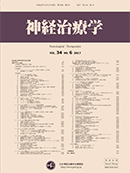Volume 39, Issue 4
Displaying 1-50 of 108 articles from this issue
-
2022Volume 39Issue 4 Pages 423-428
Published: 2022
Released on J-STAGE: December 27, 2022
Download PDF (454K)
-
2022Volume 39Issue 4 Pages 429
Published: 2022
Released on J-STAGE: December 27, 2022
Download PDF (139K) -
2022Volume 39Issue 4 Pages 430-434
Published: 2022
Released on J-STAGE: December 27, 2022
Download PDF (777K) -
2022Volume 39Issue 4 Pages 435-438
Published: 2022
Released on J-STAGE: December 27, 2022
Download PDF (1436K) -
2022Volume 39Issue 4 Pages 439-443
Published: 2022
Released on J-STAGE: December 27, 2022
Download PDF (398K) -
2022Volume 39Issue 4 Pages 444-446
Published: 2022
Released on J-STAGE: December 27, 2022
Download PDF (353K) -
2022Volume 39Issue 4 Pages 447
Published: 2022
Released on J-STAGE: December 27, 2022
Download PDF (196K) -
2022Volume 39Issue 4 Pages 448-452
Published: 2022
Released on J-STAGE: December 27, 2022
Download PDF (1019K) -
2022Volume 39Issue 4 Pages 453-457
Published: 2022
Released on J-STAGE: December 27, 2022
Download PDF (1828K) -
2022Volume 39Issue 4 Pages 458
Published: 2022
Released on J-STAGE: December 27, 2022
Download PDF (191K)
-
2022Volume 39Issue 4 Pages 459
Published: 2022
Released on J-STAGE: December 27, 2022
Download PDF (244K) -
2022Volume 39Issue 4 Pages 460-463
Published: 2022
Released on J-STAGE: December 27, 2022
Download PDF (514K) -
2022Volume 39Issue 4 Pages 464
Published: 2022
Released on J-STAGE: December 27, 2022
Download PDF (184K) -
2022Volume 39Issue 4 Pages 465-467
Published: 2022
Released on J-STAGE: December 27, 2022
Download PDF (336K) -
2022Volume 39Issue 4 Pages 468-471
Published: 2022
Released on J-STAGE: December 27, 2022
Download PDF (541K) -
2022Volume 39Issue 4 Pages 472-476
Published: 2022
Released on J-STAGE: December 27, 2022
Download PDF (747K)
-
2022Volume 39Issue 4 Pages 477
Published: 2022
Released on J-STAGE: December 27, 2022
Download PDF (176K) -
2022Volume 39Issue 4 Pages 478-483
Published: 2022
Released on J-STAGE: December 27, 2022
Download PDF (1227K) -
2022Volume 39Issue 4 Pages 484-488
Published: 2022
Released on J-STAGE: December 27, 2022
Download PDF (417K) -
2022Volume 39Issue 4 Pages 489-494
Published: 2022
Released on J-STAGE: December 27, 2022
Download PDF (555K) -
2022Volume 39Issue 4 Pages 495-499
Published: 2022
Released on J-STAGE: December 27, 2022
Download PDF (2774K)
-
2022Volume 39Issue 4 Pages 500
Published: 2022
Released on J-STAGE: December 27, 2022
Download PDF (258K) -
2022Volume 39Issue 4 Pages 501-505
Published: 2022
Released on J-STAGE: December 27, 2022
Download PDF (981K) -
2022Volume 39Issue 4 Pages 506-509
Published: 2022
Released on J-STAGE: December 27, 2022
Download PDF (752K) -
2022Volume 39Issue 4 Pages 510-513
Published: 2022
Released on J-STAGE: December 27, 2022
Download PDF (344K) -
2022Volume 39Issue 4 Pages 514-516
Published: 2022
Released on J-STAGE: December 27, 2022
Download PDF (457K) -
2022Volume 39Issue 4 Pages 517-521
Published: 2022
Released on J-STAGE: December 27, 2022
Download PDF (633K)
-
2022Volume 39Issue 4 Pages 522
Published: 2022
Released on J-STAGE: December 27, 2022
Download PDF (263K) -
2022Volume 39Issue 4 Pages 523
Published: 2022
Released on J-STAGE: December 27, 2022
Download PDF (186K) -
2022Volume 39Issue 4 Pages 524
Published: 2022
Released on J-STAGE: December 27, 2022
Download PDF (204K) -
2022Volume 39Issue 4 Pages 525
Published: 2022
Released on J-STAGE: December 27, 2022
Download PDF (193K) -
2022Volume 39Issue 4 Pages 526-529
Published: 2022
Released on J-STAGE: December 27, 2022
Download PDF (411K)
-
2022Volume 39Issue 4 Pages 530
Published: 2022
Released on J-STAGE: December 27, 2022
Download PDF (273K) -
2022Volume 39Issue 4 Pages 531
Published: 2022
Released on J-STAGE: December 27, 2022
Download PDF (196K) -
2022Volume 39Issue 4 Pages 532-534
Published: 2022
Released on J-STAGE: December 27, 2022
Download PDF (405K) -
2022Volume 39Issue 4 Pages 535-538
Published: 2022
Released on J-STAGE: December 27, 2022
Download PDF (443K) -
2022Volume 39Issue 4 Pages 539
Published: 2022
Released on J-STAGE: December 27, 2022
Download PDF (212K) -
2022Volume 39Issue 4 Pages 540
Published: 2022
Released on J-STAGE: December 27, 2022
Download PDF (220K)
-
2022Volume 39Issue 4 Pages 541
Published: 2022
Released on J-STAGE: December 27, 2022
Download PDF (231K) -
2022Volume 39Issue 4 Pages 542-545
Published: 2022
Released on J-STAGE: December 27, 2022
Download PDF (535K) -
2022Volume 39Issue 4 Pages 546-549
Published: 2022
Released on J-STAGE: December 27, 2022
Download PDF (948K) -
2022Volume 39Issue 4 Pages 550
Published: 2022
Released on J-STAGE: December 27, 2022
Download PDF (152K) -
2022Volume 39Issue 4 Pages 551
Published: 2022
Released on J-STAGE: December 27, 2022
Download PDF (179K) -
2022Volume 39Issue 4 Pages 552
Published: 2022
Released on J-STAGE: December 27, 2022
Download PDF (192K)
-
2022Volume 39Issue 4 Pages 553
Published: 2022
Released on J-STAGE: December 27, 2022
Download PDF (229K) -
2022Volume 39Issue 4 Pages 554-557
Published: 2022
Released on J-STAGE: December 27, 2022
Download PDF (743K) -
2022Volume 39Issue 4 Pages 558
Published: 2022
Released on J-STAGE: December 27, 2022
Download PDF (216K) -
2022Volume 39Issue 4 Pages 559-563
Published: 2022
Released on J-STAGE: December 27, 2022
Download PDF (903K) -
2022Volume 39Issue 4 Pages 564-568
Published: 2022
Released on J-STAGE: December 27, 2022
Download PDF (1971K) -
2022Volume 39Issue 4 Pages 569
Published: 2022
Released on J-STAGE: December 27, 2022
Download PDF (202K)
